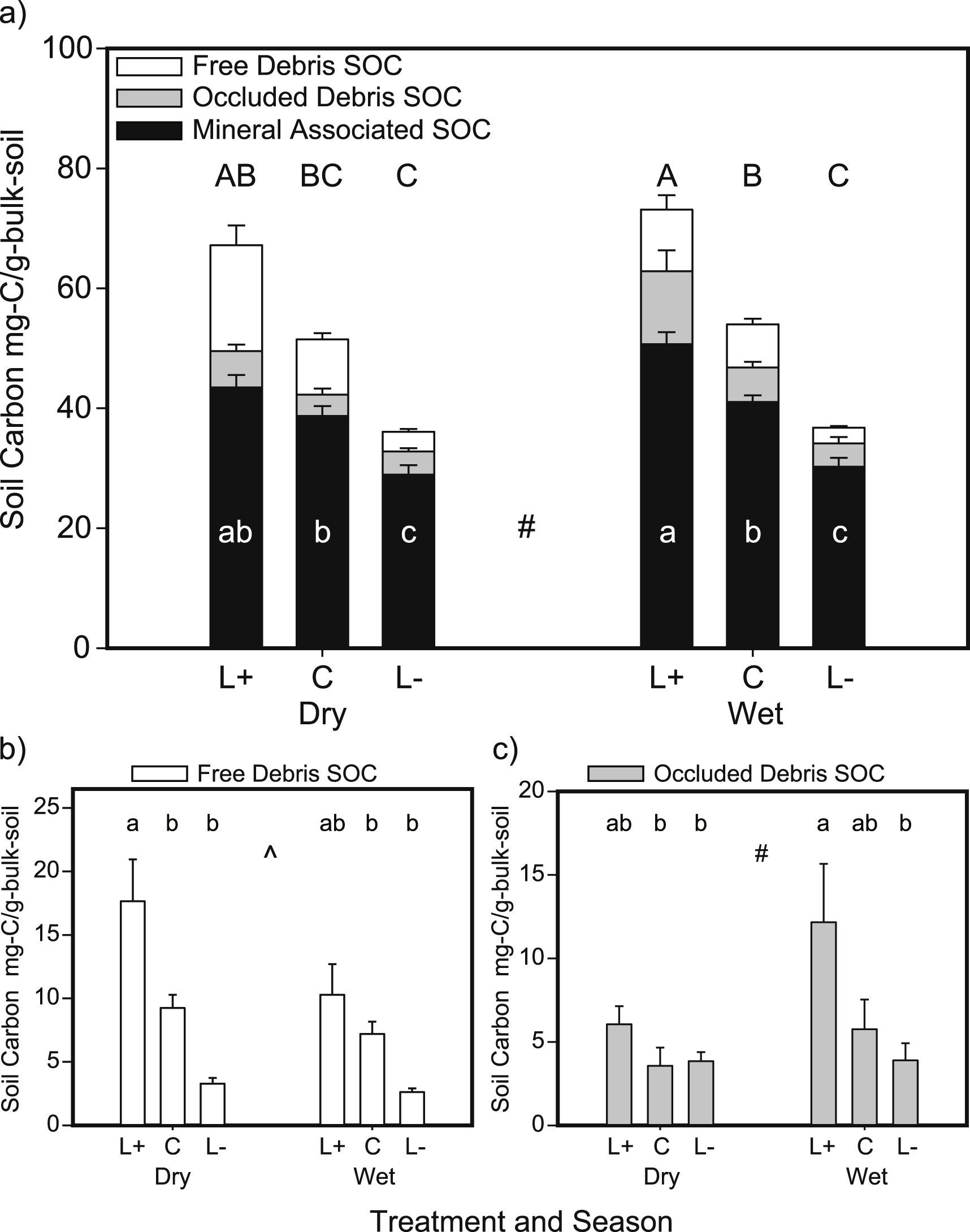June 23, 2018
Changes in Leaf Litter Inputs to Tropical Forest Soils over Decade Change Quantity and Character of Soil Carbon
After a decade of litter removal, remaining soil carbon retained is older and richer in lipids and proteins than control forest soils.

(A) Bulk soil C concentrations, made up of three SOC fractions, are shown for litter addition (L+), control (C), and litter removal (L-) plots during a wet and dry season (0 – 5 cm depth). Bulk soil C concentrations were significantly greater in L+ versus C and L-, driven primarily by greater mineral-associated SOC. (B) Free-debris SOC was greater in L+ versus C and L-, with the largest treatment effect during the dry season. (C) Occluded-debris SOC was greater in L+ versus L-, with the largest treatment effect during the wet season. ˆ indicates significantly greater free-debris SOC during the dry season; # indicates significantly greater mineral-associated and occluded-debris SOC fractions during the wet season. Tukey HSD means separation results are shown in capital letters for bulk soil C concentrations, and lowercase letters for SOC fractions, showing differences across both seasons. Averages are shown for each fraction ± one SE for that fraction (n = 5).
[Reprinted with permission from Cusack, D., et al. "Decadal-Scale Litter Manipulation Alters the Biochemical and Physical Character of Tropical Forest Soil Carbon." Soil Biology & Biochemistry 124 199–209 (2018). DOI:10.1016/j.soilbio.2018.06.005. © 2023 Elsevier.]
The Science
Tropical forest soil carbon chemistry was sensitive to changed leaf litter biomass inputs, both for litter doubling, and for total litter removal. Soil carbon in stable organo-mineral associations increased with litter addition and declined with litter removal. This is typically thought of as the most stable fraction of soil carbon. Waxes and proteins were the most stable component of organo-mineral associations after a decade of litter removal, and remaining soil carbon was older carbon compared with control sites. Phenolic and aromatic carbon was lost from mineral associations with litter removal.
The Impact
This study shows that changes in tropical forest net primary productivity (NPP) will alter the quantity, biochemistry, and stability of carbon (C) stored in strongly weathered tropical soils. This suggests that climate change induced shifts in plant growth, and primary production will have cascading effects on soil carbon storage in carbon-rich tropical forests.
Summary
This study demonstrates that the physical and biochemical nature of soil C stocks are sensitive to changes in tropical forest NPP with global change. Most notably, the relatively stable mineral-associated soil organic carbon (SOC) fraction changed markedly following a decade of litter manipulation. Litter addition promoted the accumulation of C into relatively stable organo-mineral associations (i.e., not leachable as dissolved organic carbon), suggesting that strongly weathered tropical soils have the capacity to store more C if tropical forest NPP increases. The most stable portion of mineral-associated SOC included lipids like waxes (alkyl C) and microbial products like proteins and cell walls (N-alkyl and O-alkyl C). In contrast, plant-derived compounds, characterized by aromatic and phenolic C, formed a more dynamic portion of mineral-associated SOC, demonstrating that these compounds are less important than N-containing compounds for long-term soil C storage in strongly weathered tropical soils. Free-debris SOC accumulated during the dry season, whereas occluded-debris and mineral-associated SOC increased during the wet season, promoting greater bulk soil C content during the wet season. Thus, change in duration or severity of the dry season may interact with changes in tropical forest NPP to alter soil C storage in tropical forests. Overall, findings show that changes in tropical forest NPP will alter the quantity, stability, and biochemical character of soil C stocks.
Principal Investigator
Daniela Cusack
Colorado State University & STRI
daniela.cusack@colostate.edu
Program Manager
Daniel Stover
U.S. Department of Energy, Biological and Environmental Research (SC-33)
Environmental System Science
daniel.stover@science.doe.gov
Funding
Funding was provided by the U.S. Department of Energy (DOE) Office of Science Biological and Environmental Research (BER) Program’s Early Career Research Program Grant #DE-SC0015898, National Science Foundation (NSF) GSS grant #BCS-1437591, and a Smithsonian Tropical Research Institute Fellowship. Instrumentation and facilities support was also received from NSF EAR-IF Grant #1132124.
Related Links
References
Cusack, D., et al. "Decadal-Scale Litter Manipulation Alters the Biochemical and Physical Character of Tropical Forest Soil Carbon." Soil Biology & Biochemistry 124 199–209 (2018). https://doi.org/10.1016/j.soilbio.2018.06.005.

